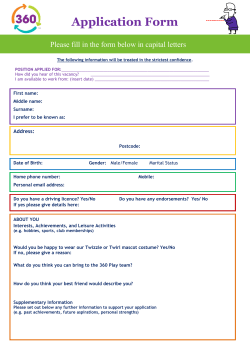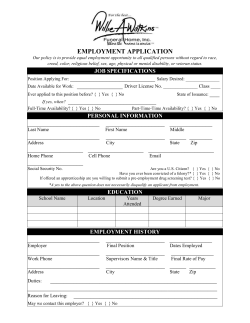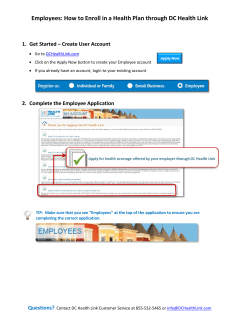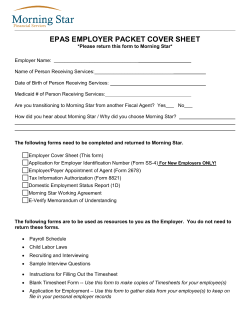
Top 10 Punch List
2015 Punch List 10 THINGS TO DO THIS YEAR www.laborlawyers.com Atlanta · Baltimore · Boston · Charlotte · Chicago · Cleveland · Columbia · Columbus · Dallas · Denver · Fort Lauderdale · Gulfport Houston · Irvine · Kansas City · Las Vegas · Los Angeles · Louisville · Memphis · New Jersey · New Orleans Orlando · Philadelphia · Phoenix · Portland · San Antonio · San Diego · San Francisco · Tampa · Washington, DC Implement a Retaliation Claim Defense Plan DON’T BE A SITTING DUCK Retaliation Claims Exposure Retaliation is the most common agency charge filed against employers Insurers report that jury verdicts and settlements are the highest in retaliation cases in comparison to other insured claims 42% of all EEOC charges and 68% of all DFEH charges filed in 2014 included claims of retaliation Retaliation cases tend to be all or nothing – either a defense verdict or a large verdict with punitive damages Most employers just plan to take the “HIT” when they need to terminate someone who has complained Retaliation Claim Avoidance Protocol The Obvious Steps Include a standalone retaliation policy in the employee handbook, and incorporate references to the policy in policies like the harassment policy Include retaliation as a subject in management training, and reference specifically in training materials Require a second layer of review when an employee is proposed for termination shortly after a protected complaint NONE OF THIS WILL ADDRESS THE FACT THAT IN MANY CONTEXTS TERMINATIONS ARE PRESUMED TO BE RETALIATORY WHEN THEY ARE CLOSE IN TIME TO A PROTECTED COMPLAINT Retaliation Claim Avoidance Protocol Think Outside the Box: For example, utilize a “validation” procedure when terminating employees shortly after a protected complaint One approach is to use an outside investigator to evaluate the facts substantiating the termination Investigator makes a factual finding regarding the legitimacy of the grounds for termination and may make a factual finding that the termination is not the result of retaliation Or, the investigator is unable to validate the above and then you may choose to delay the termination Implement a Joint Employer Defense Plan THE EMPLOYER WITH THE MOST PAYS THE MOST. AB 1897: Joint Employer Liability Labor Code Section 2810.3: jointly liable with a labor contractor for wages, taxes, and workers’ compensation insurance Employer where labor is for work needed in “usual course of business” Only Exempt if less than 25 workers five or fewer workers provided by labor contractors at any given time Case law issues as well (e.g., Ayala – mere “right of control” decision”) Joint Employer Punch List Talk to your insurance broker Screen labor contractors Require current workers’ comp. certificate Beefed-up Personal indemnification agreements guaranty of performance Performance bonds Update the Arbitration Agreement WRITE IT LIKE YOU USE IT. Write It Like You Use It Most arbitration agreements have problems because they were “cribbed” from someone else’s documents: Unenforceable limits on how claims are arbitrated (e.g., limits on discovery, limits on damages, fake statutes of limitation, etc.) Unenforceable arbitration fee shifting provisions (e.g., parties supposed to split the fees) English as a second language issues (ESL) Linkage to arbitration agencies with undesirable rules and/or undisclosed rules (e.g., AAA) Missing a class action waiver (note: strategy call); PAGA waiver after Iskanian? If You Are Using Arbitration Because It Is Confidential . . . . AB 802 requires private arbitration companies (i.e., JAMS) to publish, at least quarterly, information regarding arbitrations, including the names of the non-consumer party (if the nonconsumer party is a corporation) and counsel, arbitrators, fees, and awards. This law applies to employment-related arbitrations. Arbitration Punch List Have the arbitration agreement reviewed by counsel annually Walk through the process that will be used when there is an arbitration Send arbitration agreement to defense counsel immediately when there is a claim Notify insurance company before taking steps to compel arbitration Question anyone who tells you the arbitration agreement is not helpful in a class action and/or PAGA action (may be right or wrong) BYOD - Tools and Devices at Work BUILD YOUR OWN DEFENSE. BYOD – Stuck Between Rock and Hard Place The Rock: Productivity - Employees who use their own devices tend to do use the for things other than work when they are supposed to work The Hard Place: Off the Clock Liability - Employees who use their own devices tend to use them for work at home when they are not supposed to be working Under The Rock: Expense Reimbursement - Employees are supposed to be reimbursed for the cost of using the device, regardless of where they use it (Cochran v. Swanns) Other: Loss of control of confidential data and employee privacy issues with employer monitoring of BYODs BYOD– Punch List Create/update BYOD policy Describe work-related reimbursement procedures (fact of payment may be more important than amount of payment) Notify employees about monitoring, remote wiping, etc., procedures, and consider getting “consent” for same Describe limitations to accessing company data and information with personal devices Have in place a mobile device management system (i.e., remote wipe technology) Incentive Compensation Practices JUST BECAUSE THEY MAKE A LOT, DOES NOT MEAN YOU CAN IGNORE THEM. The Down Time Problem Armenta v. Osmose, Inc. held that the flat rate pay of non-exempt employees could not be “averaged” over all hours worked Courts then extended the Armenta logic, distinguishing between “productive” and “non-productive” work time, to piece rate compensation arrangements, e.g., Gonzalez v. DTLA, and commission pay arrangements, e.g., Balasanyan v. Nordstrom. Commission employee issues include significant challenges with rest periods and meeting time Incentive Compensation Issues—Regular Hourly Rate Calculations All compensation, except discretionary pay, must be included in the regular hourly rate for purposes of calculating overtime wages What must be included: bonuses, spiffs, commissions, piece rate, flat rate pay What may be excluded: gifts, payments for non-work time (e.g., vacation), reporting time pay, meal period premiums, and split shift pay Commission Agreements Must Be in Writing and Signed by the Employee Under Labor Code section 2751, commission agreements must: be in writing, describe the method by which commissions are computed and paid be signed by the employee, with a copy to the employee, and have a signed “receipt,” retained by the employer, acknowledging both receipt of, and agreement with, the commission agreement Incentive Compensation – Punch List Update commission agreements (consider exemption issues and termination issues) Address the downtime problem Incorporate bonuses into overtime calculations Ensure bonus systems are clearly explained in writing Paid Sick Leave HERE IT COMES . . . We Are All Sick of Talking About Paid Sick Leave, But Here It Comes What we all know: Effective July 1, 2015 Employers, regardless of size, must provide at least 24 hours or 3 days of paid sick leave to employees who work 30 or more days within a year from commencement of their employment. Covers almost all employees including part-timers and temporary employees; only exceptions are employees covered by union contract, in-home caregivers and airline flight crews. Employees may begin using paid sick leave on the 90th day of employment. Strident anti-retaliation provisions, including a rebuttable presumption of retaliation under certain circumstances Paid Sick Leave – Keep Your Eye On Developments Clarifying Legislation Introduced. AB 304 (introduced March 26, 2015) proposes revisions to paid sick leave law, including the following: Allow for different accrual rates For employees with variable wage rates, sick pay could be calculated the same way overtime wages are calculated (rather than the current 90-day look-back scheme) Stay tuned… Paid Sick Leave – Keep Your Eye On DLSE Webpage DLSE Paid Sick Leave Webpage: http://www.dir.ca.gov/dlse/ab1522.html The DLSE last updated its FAQs in February 2015, with no indication of when the next update will occur The DLSE also put on a webinar on April 8, 2015, and released an informational slide deck The DLSE webinar materials suggest that employers are required to provide written notice of sick leave used AND sick leave available. This position conflicts with Labor Code section 246(h), which requires that the written notice on pay day “set forth the amount of paid sick leave available.” Stay tuned… Paid Sick Leave Punch List Update Written Policies: Make sure your written policies comply with sick leave law Update Wage Statements: Include written notice of amount of available paid sick time Update WTPA Notice: Include information regarding entitlement to paid sick leave Retain Records: Employer must retain paid sick leave records for at least 3 years Display Poster: Can download poster from DLSE webpage Train Managers: Train managers to ensure careful documentation of discipline or termination based on attendance issues to protect against claims of retaliation Train HR and Payroll Personnel: Train HR and payroll personnel to accurately track and record accrual, usage, and pay for sick leave Implement New CFRA Regulations MIND THE MINUTIA IN YOUR POLICIES. Updated CFRA Regulations-Highlights Time to respond to a CFRA leave request shortened Old: 10 days New: 5 days Tenure requirement changed Old: Employee had to meet one-year length-of-service requirement before commencing leave New: Employee may be eligible for leave IF s/he will meet one-year length-of-service requirement while on leave Posting requirement expanded to include “applicants” Old: CFRA provisions and procedures for filing complaints must be posted “in conspicuous places where employees are employed” New: Adds requirement that posting be displayed “prominently where it can be readily seen by employees and applicants for employment… electonic posting is sufficient to meet this requirement.” Updated CFRA Regulations-Highlights Second opinion options narrowed Old: Employer only needed a “reason” to doubt validity of employee’s medical certification New: Employer must have a “good faith objective reason” to doubt validity of employee’s medical certification Ability to contact health care provider limited Old: Employer permitted to contact health care provider to authenticate, or seek clarification of, a medical certification New: Employer may contact health care provider only to authenticate a medical certification (note: no further details have yet been provided) CFRA Update Punch List Update notice documents, written eligibility and determination letters and forms, including Health Care Provider Certification Update CFRA/FMLA Handbook policy Update CFRA/FMLA Poster Update leave management process timeline to ensure 5-day required response Train supervisors and Human Resource personnel The Interactive Process IT IS TIME TO STANDARDIZE. The Interactive Process - Steps Step 1: provide written communication inviting/opening an interactive process (document reason for initiating interactive process), request meeting, and give employee reasonable time to respond, then follow up if no response Step 2: before meeting, determine essential functions of the position, prepare/update written job description Step 3: Conduct initial meeting; get agreement on essential functions of the position; explore/understand employee’s requested accommodation; request medical certification to support need for accommodation; send confirming communication to employee summarizing meeting Step 4: Identify other potential reasonable accommodations; continue communications regarding other potential reasonable accommodations (document all communications) Step 5: Repeat as needed. If first accommodation does not work, consider others Disability Accommodation/Interactive Process – Punch List Create/update form letters and communications to employee/applicant for each step of the process Create/update timeline for each step of the process Create/update written policies pertaining to disability accommodation and interactive process Update Leave policies to include transitions to accommodation and interactive process policies Create/update training programs for line managers and Human Resource/administrative personnel NLRB THE THIRD LEGISLATIVE BRANCH. Report of the General Counsel Concerning Employer Rules On March 18, 2015, NLRB General Counsel issued a Memorandum titled, “Report of the General Counsel Concerning Employer Rules” The mere maintenance of a work rule that if enforced would chill or interfere with employee protected activity can violate Section 7 of the NLRA if: “employees would reasonably construe the rule’s language to prohibit Section 7 activity;” “the rule is promulgated in response to union or other Section 7 activity; or” “the rule is actually applied to restrict the exercise of Section 7 rights.” Impact on Work Rules and Employee Handbooks The General Counsel cited the following as unlawful rules: “[B]e respectful to the company, other employees, customers, partners, and competitors;” Do “not make fun of, denigrate, or defame your co-workers, customers, franchisees, suppliers, the Company, or our competitors”; “Be respectful of others and the Company;” No “[d]efamatory, libelous, slanderous, or discriminatory, comments about [the Company], its customers and/or competitors, its employees or management; “Refrain from any action that would harm persons or property or cause damage to the Company’s business or reputation;” Impact on Work Rules and Employee Handbooks The General Counsel cited the following as unlawful rules: “Don’t pick fights” online. Don’t make “insulting, embarrassing, hurtful or abusive comments about other company employees online”, and “avoid the use of offensive, derogatory, or prejudicial comments.” Do not send “unwanted, offensive or inappropriate” emails. New Quickie Elections Rule Becomes effective April 14, 20151 Will shorten time to election Current average 38 days To “earliest date practicable” Likely will end up being 15-21 days Requires disclosure of detailed employee information Limits pre-election litigation of issues 1 Unless enjoined by court action NLRB – Punch List Revise handbooks and other work rules documents Train managers Identify and resolve “wedge” issues Recognize employees Keep wages and benefits competitive Criminals GOVERNMENT WANTS THEM ON YOUR PAYROLL, NOT THEIRS. What Are You Not Allowed to Ask Applicants in California? Labor Code section 432.7 Arrest or detention that did not result in conviction Referral to, and participation in, any pretrial or post-trial diversion program A conviction that has been judicially dismissed or ordered sealed pursuant to law any record of arrest or detention that did not result in conviction, or any record regarding a referral to, and participation in, any pretrial or post-trial diversion program, or concerning a conviction that has been judicially dismissed or ordered sealed pursuant to law Labor Code section 432.8 Marijuana misdemeanor convictions that are more than two years old Recruiting and Hiring – Punch List Review/Update Employment Application: Applicable ban-the-box limitations Delete requests for social security numbers or birth dates Include arbitration agreement Update pre-employment background check policies, procedures, and forms: Authorization forms Pre-adverse decision notification form Adverse decision notification form 2015 Punch List 10 THINGS TO DO THIS YEAR www.laborlawyers.com Atlanta · Baltimore · Boston · Charlotte · Chicago · Cleveland · Columbia · Columbus · Dallas · Denver · Fort Lauderdale · Gulfport Houston · Irvine · Kansas City · Las Vegas · Los Angeles · Louisville · Memphis · New Jersey · New Orleans Orlando · Philadelphia · Phoenix · Portland · San Antonio · San Diego · San Francisco · Tampa · Washington, DC
© Copyright 2025










